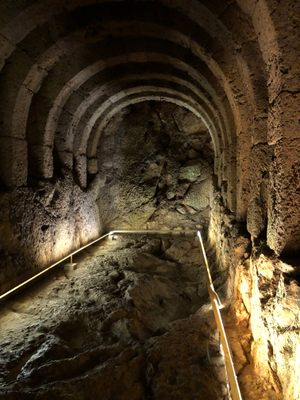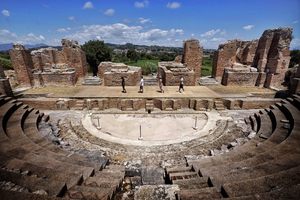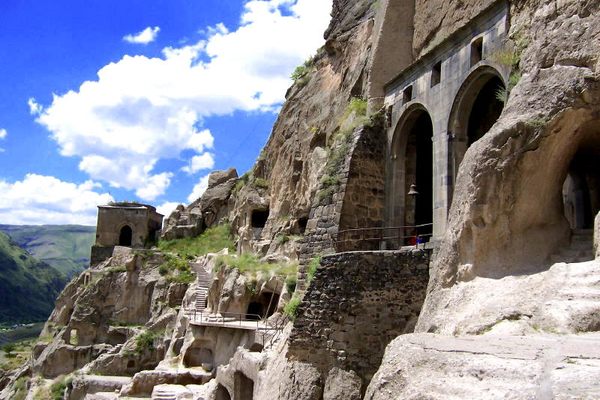About
Although there were many oracles in ancient Greece, there is only one known oracle of the dead. It was an entryway to the underworld, and a place where the shades of the dead could - under special circumstances - reveal the future to the living. It was the place that Homer sent Odysseus to seek advice from a long-dead oracle, and where he was horrified by visions of Hades, and it also appears in a sordid chapter of Herodotus' Histories.
The site rests atop a hill near the confluence of the Acheron ("River of woe" in Greek), Pyriphlegethon ("Flaming with fire") and Cocytus ("River of wailing"), three of the five rivers associated with Hades, was identified in 1958 by the Greek archaeologist Sotirios Dakaris. Dating to the 3rd or 4th century BC, the ruins are 72 feet square, with 11 foot thick walls, and subterranean chambers.
The ancient Greeks believed that the souls of the dead entered the underworld though subterranean fissures, and that in special cases like this, arrangements could be made to communicate with the dead. This was used as an opportunity to commune with lost loved ones, and also to seek out the future telling skills of the dead.
In the Odyssey, Odysseus descended into Hades to find the soul of Teiresias who might foretell his future, but once at the oracle, he saw much more than he had bargained for:
"Thus solemn rites and holy vows we paid to all the phantom-nations of the dead; Then died the sheep: a purple torrent flow'd, And all the caverns smoked with streaming blood. When lo! appear'd along the dusky coasts, Thin, airy shoals of visionary ghosts: Fair, pensive youths, and soft enamour'd maids; And wither'd elders, pale and wrinkled shades; Ghastly with wounds the forms of warriors slain Stalk'd with majestic port, a martial train: These and a thousand more swarm'd o'er the ground, And all the dire assembly shriek'd around. Astonish'd at the sight, aghast I stood, And a cold fear ran shivering through my blood; Straight I command the sacrifice to haste, Straight the flay'd victims to the flames are cast, And mutter'd vows, and mystic song applied to grisly Pluto, and his gloomy bride." - Odyssey book 11
The oracle is also mentioned in a charming passage from Herodotus wherein a brutal tyrant sends an emissary to the oracle of the dead at Ephyra to ask his dead wife about where she hid some money. The dead wife refuses to answer, on the grounds that she is cold in the underworld, because her husband had not burnt clothes for her at the time of her death. As a guarantee of her identity, she tells the messenger that her husband had sex with her corpse. Apparently this was enough confirmation for the living husband, who promptly set about stripping the clothing off of all of the local women and burning them, so that his dead wife would give up the location of the money.
Visitors wishing to communicate with the dead would have entered the dark chamber and followed specific rituals outlined for the protection from and communication with the dead which would have taken several days. When ready, a priest would usher them deeper inside for a ritual animal sacrifice, and through three gates symbolic of Hades.
Pilgrims expected to see the images of the dead as shadows against the flickering lantern light. These visions may have been enhanced by the special diet recommended in the days before entering the sanctuary, which some have described as including hallucinogens. Interestingly, inside the underground chambers, archaeologists have found mechanical contrivances which may have been used to enhance the appearance of animated dead. After a session with the dead, pilgrims were forbidden to talk about what they learned for fear of Hades claiming their own lives in exchange.
Long after the destruction in 167 BC, an 18th century monastery dedicated to St. John the Baptist was built at the site. There has been some skepticism about the identification of these ruins as the Necromanteion. In 1979 German scholar Dietwulf Baatz recognized elements in the structure as mounts for third-century BC catapults implying a fortification of some sort. More recently a Greek-American study of towers in the area suggested that the ruins may have been the base of an agricultural tower, and the underground chambers storage areas for water or grain, rather than mystical communication with fortune-telling dead. At least for now, the place remains officially identified as the Necromanteion, and has been preserved as such.
Related Tags
Know Before You Go
Near the village of Mesopotamos, use the village as a marker for GPS directions and coordinates.
Community Contributors
Added By
Published
March 27, 2010








































